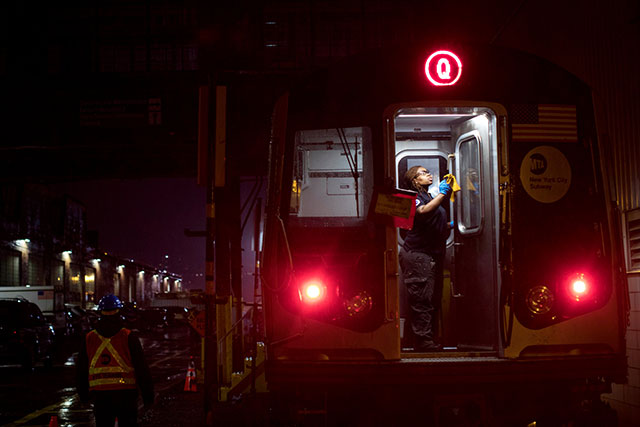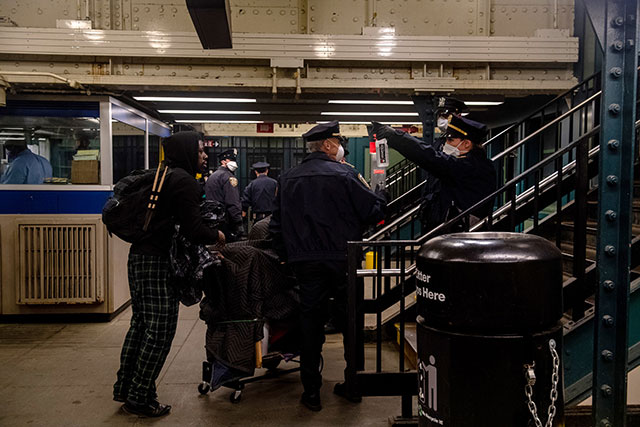
May 2020
Shutting Down 24/7 Service Is
No Answer to NYC Subway Crisis

Subway worker disinfecting subway car at the Coney Island Yard in Brooklyn, March 3. Shutting down late night service won't help cleaning cars, there’s nowhere to park the trains. (Photo: Dave Sanders for The New York Times)
On May 6, the New York City subway system began shutting down daily for four hours, from 1 a.m. to 5 a.m. It is the first scheduled cancellation of late-night service in the system’s 115-year history. According to the announcement by the Metropolitan Transportation Authority (MTA), the aim is to “intensify disinfecting operations, cleaning its fleet of thousands of cars and buses every night” amid the coronavirus pandemic. The actual purpose is to eject homeless people who have increasingly been camped out on the trains during the crisis. To that end, the city deployed 1,000 police to nearly every one of the 472 stations in the system, the largest in the world, to carry out the removals.
Since the shutdown would cause turmoil for the 11,000 riders who have been using the subway during those hours lately (normally it is 75,000), among them many “essential workers” heading for early morning shifts, an “Essential Connector” program was set up using app-taxis like Uber and Lyft. While that might get nurses and other staff to hospitals, the workers heading to jobs like bakeries, grocery stores, distribution warehouses or construction sites would have a hard time getting a free ride. They would have to rely on the 344 additional buses the MTA put on the road. But that will mean more pressure on bus drivers, at least two dozen of whom have died from COVID-19 in the last six weeks.
This is all part of gearing up to “reopen the economy” after the unprecedented quarantine that for the last six weeks has brought the “city that never sleeps” to a virtual standstill, as much of the rest of the country has shut down as well. Despite the “shelter in place” order that emptied Manhattan streets, the virus has raged through NYC. With 175,000 confirmed cases of COVID-19 (in reality surely many times more, as relatively few have been tested) and 20,000 deaths, the city is the epicenter of the pandemic in the United States and worldwide. Yet while the numbers of new cases reported and of people dying have been declining, lifting the stay-at-home orders, even gradually, could lead to a new surge.
In New York City less than half of all families have a car and a large majority of workers commute by mass transit. To get people back to work with the virus as dangerous as ever, the authorities will have to again pack the subways, where “social distancing” is impossible. So in addition to requiring face covering on public transit, they are focused on forcing the homeless off. At his daily coronavirus briefing on April 28, New York governor Andrew Cuomo held up a front-page photo of people sleeping in the cars, declaring “This is disgusting, what is happening on those subway cars.” He added, “It’s not even safe for the homeless people to be on trains.” So the state and city shut down the system overnight, and call out the cops to roust the riders.
So what is “disgusting”? Cuomo blames the homeless themselves. But the fact that large numbers of people are forced to ride the trains because they have no other safe place to go is disgusting. The fact that there is no network of public toilets and showers where they can clean up is disgusting. The fact that tens of thousands of apartments stand empty while thousands have no bed to sleep in is disgusting. The fact that the shelters are jammed, often violent and now hotbeds of COVID-19 infection is disgusting. And that’s a main reason why the homeless are avoiding them, feeling safer riding the rails for a fitful sleep. As a subway conductor remarked, “They need to have some type of place for people to go that isn’t the buses” (The City, 5 May).
 NYPD
throwing people off the subway at Bronx station, 6 May 2020. (Photo: Dave Sanders for The New
York Times)
NYPD
throwing people off the subway at Bronx station, 6 May 2020. (Photo: Dave Sanders for The New
York Times)He’s right. City officials know this well, which is why the Department of Homeless Services (DHS) sent 100 social workers to 30 stations on the first night of the shutdown. But they had nothing to offer but virus-impacted shelters. Yes, there is a problem of large numbers of homeless camped out in the subways, affecting other riders and workers. Want to solve it? Provide everyone who needs housing a comfortable, safe place to stay, and plenty of social services. Start with the thousands of rooms standing empty in NYC hotels. DHS leases 2,500 rooms, a drop in the bucket. Transit unions and the rest of the labor movement should call to put up everyone needing shelter in the hotels, and to occupy the thousands of vacant second homes in NYC, as many as needed. But the late-night shutdown is ultimately not about the homeless.
Nor is it about cleaning the trains, which shouldn’t just be once a day – or once in three days, as it’s been lately. The MTA made a show of sending 500 workers to clean cars on the first night. Yet it doesn’t have yards big enough to park the entire fleet. Even amid the shutdown it ran 135 trains all night for the use of police and transit workers. Cleaning should be staggered throughout the day. The unions should demand that the MTA hire several thousand union cleaners to disinfect every train car and bus after every run, as most Chinese cities do. It could buy some of those robots (cost: $129,000 each) used on the Hong Kong subway to spray hydrogen peroxide inside train cars. The fact that this isn’t being done points to the real issue – money, and profits.
Leading capitalist spokesmen in New York have long called to get rid of all-night subway service, as part of an overall plan to make the transit system more “cost-effective.” The head of the Regional Plan Association (whose board includes real estate moguls, a top Google executive and NYC mayor Bill de Blasio’s former deputy mayor), told WCBS (30 November 2017) that the “era of 24-hour subway service is over,” that late-night service should be replaced by buses and app-taxis. RPA boss Tom Wright added: “We think that the city subway system needs shock therapy.” Meaning what? The RPA’s Fourth Regional Plan he introduced calls to “to change the responsibilities of MTA’s workers” or … “reduce the number of those positions.” So that’s it.
This would mainly be accomplished by going over to one-person-train-operation (OPTO). Ultimately, “A driverless subway will save the agency billions of dollars annually,” said the RPA report, Save Our Subways: A Plan to Transform New York City’s Rapid Transit System (June 2018). The report hailed the “fully unattended train operations” on the Paris Metro’s Line 1, which incidentally was the only line that kept up full service in the recent month-long strike by Paris transit workers. How very cost-effective: lower wage costs and no strikes! But passenger safety? Like during derailments, of which the aging NYC subways have had quite a few. As we wrote of an earlier (2014) RPA call for OPTO and “full unattended train operations”:
“This is a recipe for a deadly disaster. Imagine what the casualties from the June 27 [2017] derailment of the A train at 125th Street would have been if there had been no transit workers to guide passengers through the smoke-filled tunnel. Luckily, in the past TWU Local 100 has resisted such moves.”
–“NYC Transit Summer of Hell? What about Winter, Spring and Fall?” (August 2017), reprinted in The Internationalist No. 50, Winter 2017
Late-night NYC subway service has been deteriorating for years. It used to be that the worst was getting stuck behind the garbage train. But since subway “modernizers” launched their “Fasttrack” program a few years ago, it has gone to hell, with half-hour waits (or more) between trains. When the RPA first called for shutting down overnight service, Mayor de Blasio said that for New Yorkers, “Twenty-four-hour subway service is part of our birthright. You cannot shut down the subway at night . . . this is a 24-hour city.” Now he says he only agreed to shutting down late-night service on the basis of Governor Cuomo’s assurance that it was only “temporary.” You think? Look at the last sentence of the MTA announcement:
“The MTA will resume overnight service between the period of 1-5 a.m. when customer demand returns, and innovative and efficient disinfecting techniques have been successfully deployed systemwide.”
I.e., most likely never. Media accounts reporting that the trains would be shut down overnight “for the foreseeable future” more accurately reflect reality. Yet the reality is also that New York City, the center of finance capital, entertainment and much more, does function 24/7 year-round. Talk of replacing trains with frequent bus service between boroughs and along the 245-mile subway routes is sucker-bait: it won’t happen. For anyone who believes the MTA’s empty assurances, or anything coming out of the mouth of the fork-tongued mayor, who never delivers on his promises, our word to the wise is: don’t fall for it. Next, they’ll have a bridge to sell you.
To restore 24-hour New York City subway service, we need workers control. ■
